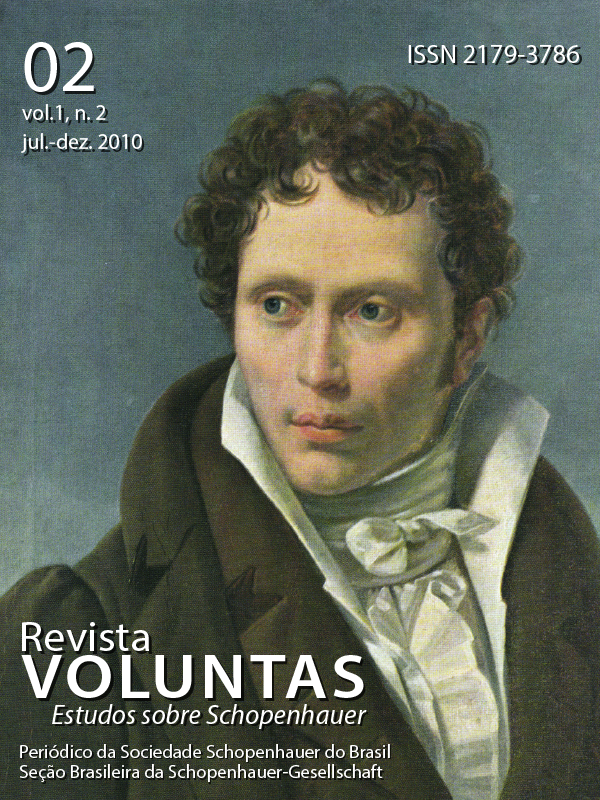O sentido da noção de sublimação na filosofia de Schopenhauer
DOI:
https://doi.org/10.5902/2179378634125Keywords:
Schopenhauer, Sublimation, DesireAbstract
Freud thinks sublimation ("Sublimierung") as a modification of actions and objects of satisfaction ("Befriedigung") of sexual impulses, caused by the difference between the degree of pressure of desire and the possibilities of direct satisfaction. The difference between one thing and another, results from the factor that drives the impulses toward their destinations desexualized. These forms enable improvement of language and of cultural production that result in the civilizing process, capitalizing on the forces of sexuality and redirecting to target socially productive. Therefore, all human activity is always sexualized to some degree and seeks satisfaction. But in Schopenhauer’s case occurs the same? The philosopher of the Will uses two different words: sublimation ("Sublimierung"), which accounts for a conversion process of beautification and subtilization representations, although not made any systematic attempt to directly target impulse. This notion is complemented by the concept of the sublime ("Erhabenen") present especially in the Metaphysics of the Beautiful ("Metaphysik des Schönen"), which characterizes the man as "dark and stormy impetus of wanting", which has the polarity "of the genitals as their focus," and while the contrast polarity of the brain, which in the language of the philosopher is the "eternal subject, free, serene and pure knowledge."Downloads
References
SW Sämtliche Werke, ed.Wolfgang Frhr. von Löhneysen, Frankfurt, 1986, 5 vols. As referências a essa edição são indicadas pelas iniciais SW, seguidas do número do volume em algarismo romano e do número da página em número arábico.
SEH Über das Sehn und die Farben. Sobre a visão e as cores. Tradução de Erlon José Paschoal. São Paulo: Nova Alexandria, 2005.
WWV Die Welt als Wille und Vorstellung, [O Mundo Como Vontade e Representação] – 1819 (1 a. Ed.), 1844 (2a. ed.); 1859 (3a. ed). Tradução brasileira de Jair Barboza, São Paulo, Unesp, 2005. As referências a essa tradução são indicadas pelas iniciais VR,
seguidas do número da página.
WWV, E. Die Welt als Wille und Vorstellung, Ergänzungen, [O Mundo Como Vontade e Representação: Complementos] – 1844 (2 a. ed.); 1859 (3a. ed). Metafísica do amor / Metafísica da morte. Tradução de Jair Barboza. São Paulo: Martins Fontes, 2000. As referências a essa tradução são indicadas pelas iniciais VRII, seguidas do número da página.
E Die Beiden Grundprobleme der Ethik. [Os Dois Problemas Fundamentais da Ética] – 1841.
FM Die Beiden Grundprobleme der Ethik, II: Über das Fundament der Moral, Os Dois Problemas Fundamentais da Ética, II: Sobre o Fundamento da Moral – 1841. Tradução brasileira de Maria Lúcia Cacciola, São Paulo, Martins Fontes, 1995. As referências a essa tradução são indicadas pelas iniciais FM, seguidas do número da página em número arábico.
PP Parerga und Paralipomena, I/II, SW V, VI – 1851. Tradução brasileira do seguinte texto presente na obra: (C) Fragmentos para a história da filosofia. Tradução de Maria Lúcia Mello e Oliveira Cacciola. São Paulo: Iluminuras, 2002.
KSA Kritische Studienausgabe. Org. Giorgio Colli e Mazzino Montinari, 15 vols., Munique, DTV/ de Gruyter, 2ª ed., 1999.
PCS Traduções de Paulo César de Souza. (E) Genealogia da Moral – uma polêmica. São Paulo: Companhia das Letras, 1998.
SA Die S Freud-Studienausgabe. S. Fischer Verlag, 1980. Org. , 11 vols., Munique, DTV/ de Gruyter, 2ª ed., 1999.
OP Obras Psicológicas de Sigmund Freud (Edição Luiz Hanns), 3 vol. Rio de Janeiro: Imago, 2004.
BARBOZA, Jair. A Metafísica do belo de Arthur Schopenhauer. São Paulo: USP, 2001.
CACCIOLA, Maria Lúcia Oliveira e Mello. Schopenhauer e a questão do dogmatismo. São Paulo: Editora da USP, 1994.
KANT, I. Kants Werke. Akademie Textausgabe. 29 vols. Berlin, Walter de Gruyter, 1959-2002.
SONDAG, Y. Nietzsche, Schopenhauer, o ascetismo e a psicanálise. Revue Philosophique, set. 1971.
FONSECA, E. R. da. Corpo e mundo em Schopenhauer e Freud. Curitiba: Dissertação de mestrado apresentada ao Departamento de Filosofia da UFPR, 2003.
GUPTA, R. Schopenhauer: His Philosophical achivievement/ Freud and Schopenhauer. New Jersey: Barney & Nobles Books, 1980.
KAMATA, Y. Platonishe Idee und anschauliche Welt bei Schopenhauer. Schopenhauer Jahrbuch n° 70, Frankfurt am Main, 1989, pp. 84-93.
MOURA, A. H. de. As pulsões. São Paulo: Escuta, 1995.
PROCTOR-GREG, N. Schopenhauer and Freud. Psychoanal. Q. 25, 197-214, 1956
Downloads
Published
How to Cite
Issue
Section
License
The submission of original manuscripts to this journal implies the transference, by the authors, of the copyrights for printed and digital publication. The copyrights of a published manuscript belong ultimately to the author, and only the copyright for its first publication is reserved to the journal. Authors may only use the same results in other publications explicitly indicating this journal as the medium of the original publication.
Licence
Attribution-NonCommercial-ShareAlike 4.0 International (CC BY-NC-SA 4.0) - This license lets others remix, tweak, and build upon your work non-commercially, as long as they credit you and license their new creations under the identical terms.






